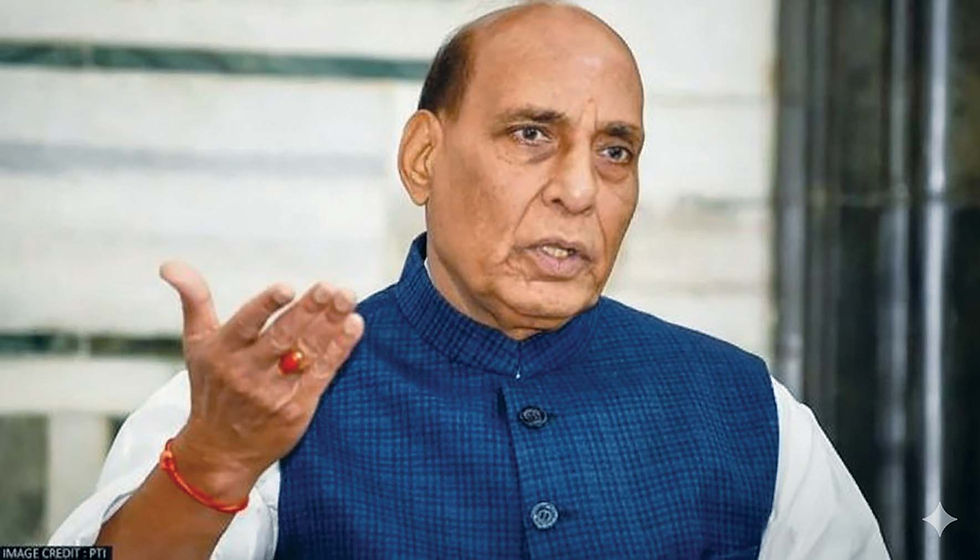Atmanirbhar Bharat: An Imperative for Defence
- Commodore S.L. Deshmukh

- Sep 22
- 4 min read

When Indian policymakers talk of an ‘Atmanirbhar Bharat’ (self-reliant India), the phrase generally conjures images of solar panels, electric vehicles or homegrown smartphones. But nowhere is the imperative more pressing than in the country’s defence sector. For decades, India’s armed forces have struggled with an unhappy paradox: they are among the world’s largest, yet remain acutely dependent on foreign suppliers for critical hardware, from fighter jets to submarines.
This is no minor vulnerability. India’s neighbours include two nuclear-armed adversaries - Pakistan and China - whose military modernisation has been rapid and relentless. Yet India’s own defence preparedness has lagged behind, hobbled by inadequate capital budgets, bureaucratic sloth, an ageing industrial base and cumbersome procurement procedures. Revenue expenditure on salaries and pensions devours the lion’s share of defence allocations, leaving too little for modernisation. The result is that India continues to rely on imports to plug crucial gaps, leaving its national security hostage to shifting geopolitical winds.
Foreign suppliers
India’s import dependency is spread across a handful of partners, each with its own set of entanglements. Israel has emerged as one of the most reliable suppliers. India is the single biggest destination for Israeli defence exports, accounting for over 40 percent of its global sales. The partnership has been productive in areas such as UAVs, missiles and loitering munitions. Yet even here, constraints abound. Much of Israeli kit includes American-origin components, potentially vulnerable to Washington’s vetoes. Moreover, the holy grail of any defence deal - transfer of technology - remains elusive, hampered by Israel’s stringent sectoral regulations and reluctance to part with intellectual property. For India, this means quick access to battlefield-proven systems, but not the know-how to build them independently.
France is often hailed in New Delhi as a dependable ally. The Rafale fighter jets, Scorpene-class submarines and ongoing naval aviation deals testify to Paris’s willingness to engage deeply. France has been more open than most Western nations in offering technology partnerships. Yet the devil lies in the detail. Indian negotiators routinely complain that the most sensitive technologies including jet engines, radar integration, source codes remain out of reach. The history of defence offsets, where French firms promised local production but fell short, continues to rankle.
Russia, India’s long-standing defence partner, has supplied everything from MiG fighters and Sukhoi jets to tanks, submarines and the coveted S-400 missile system. The BrahMos cruise missile, jointly developed, is a rare example of successful collaboration. Yet problems abound in form of poor product quality, patchy maintenance support, high life-cycle costs and chronic delays. The war in Ukraine has exposed these weaknesses brutally. With Ukrainian industries producing key spares like Zorya turbines, Indian inventories have been left scrambling.
External shocks
The United States has made significant inroads in recent years. From near-zero in 2008, bilateral defence trade has crossed $20 billion, underpinned by agreements such as LEMOA and COMCASA. Washington pitches itself as India’s natural partner in balancing China. But the relationship is not without friction. Tariff disputes, delays in supply (notably General Electric engines), offset non-fulfilment, and lack of clarity under the Defence Technology and Trade Initiative (DTTI) have slowed progress. Above all, India is wary of America’s unpredictability: its tendency to arm Pakistan, its shifting strategic priorities, and the risk of sanctions if ties with Russia or Iran deepen. Beyond these big players, India has dabbled with suppliers from Sweden, Norway, Italy and Turkey. Each comes with its own mix of opportunities and headaches. The mosaic is complicated; the dependence, glaring.
For India, defence indigenisation is no longer about prestige; it is about survival. Foreign suppliers have served the country well in moments of crisis. But over-reliance weakens strategic autonomy. It leaves India vulnerable to external shocks - from sanctions to wars in supplier countries. It limits bargaining power in diplomacy. And it slows the pace of modernisation by making India dependent on the timelines and generosity of others.
Atmanirbharta, if realised, promises several dividends. First, it would reduce strategic dependency and enhance national security. Second, it would boost domestic innovation: defence research often spills over into civilian technologies, from aerospace to electronics. Third, it would create jobs and nurture a skilled industrial ecosystem. Fourth, it would allow India not only to meet its own needs but to emerge as a credible exporter, enhancing its diplomatic heft in regions such as Africa and Southeast Asia.
The Modi government has recognised this, placing self-reliance at the heart of defence policy. Initiatives like the ‘negative import list’ (banning imports of certain categories), the corporatisation of ordnance factories, and the encouragement of private players mark important steps.
The Defence Acquisition Procedure has been tweaked to favour domestic producers. India’s exports, once negligible, touched $2.6 billion in 2024, with customers in over 80 countries.
Yet the distance to travel is vast. High-end technologies - jet engines, advanced radars, stealth platforms, nuclear submarines - remain far beyond India’s current capabilities. The Defence Research and Development Organisation (DRDO) has had patchy success, plagued by delays and cost overruns. Indigenous production often ends up reliant on imported sub-systems, undermining the goal of self-reliance. The private sector, though energetic, lacks the depth and scale to rival global primes.
Self-reliance cannot mean isolation. India will need to continue importing where it lacks expertise, while simultaneously investing in domestic capabilities. The model to emulate is not autarky but partnerships on India’s terms. Joint ventures, co-development, and smart technology transfers can accelerate capacity-building.
In an era when great-power rivalry is intensifying and wars of attrition are back in fashion, India can ill afford to be at the mercy of others for its national security.
(The author is a retired Naval Aviation Officer and defence and geopolitical analyst. Views personal.)





Comments